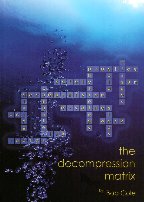 |
THE
DECOMPRESSION MATRIX
Bob Cole
Published by: The Dive Information
Company, Bigging Hill, UK in 2003.
Printed soft covers; 142
printed pages. (Each chapter is numbered from page 1)
Dimensions: 21 cms tall
by 15 cms wide.
This book attempts to explain
the myths and facts behind personal dive computers (PDC’s) and other related
decompression questions. It starts with a “potted” history of diving
and even has a history of the development of dive computers from the mechanical
Foxboro Decomputer Mk 1 (1955) and the better known SOS Decompression Metre
(c1960) to the development of the modern PDC. The book is divided
into 13 chapters: “In the Beginning”, “Traditional Decompression”, “Physiology
and Gas Movement”, “Women and Decompression”, “Personal Decompression Computers”,
“DCI Avoidance Strategies”, “Multi-Level PDC Assisted Diving”, “Dive Planning
(Gas)”, “An Introduction to SomeAlternative Decompression Systems”, “Risk
Assessment”, “DCI Recognition, First Aid and Treatment”, “Practical Decompression
(In the Real World)” and “ Round Up”. Extremely well illustrated throughout
with coloured photographs and drawings. [pt] |
 |
SCUBA
EQUIPMENT CARE AND MAINTENANCE
Michael Farley & Charles
Royer
First published By: Marcor
Publishing, Port Hueneme, USA in 1980. Many later editions.
Card covers with 176 printed
pages. Dimensions: 23 cms tall by 15 cms wide.
Extremely well illustrated
with line drawings and monochrome photographs.
This softback book gives
a good general overview of equipment care and storage. Written in
the era when regulators were both twin hose as well as single hoseand buoyancy
compensators were “horse collars” (Fenzies), a lot of the advice given
still holds today. It is broken down into chapters dealing with equipment:
“Mask, Snorkel and Fins”, “Wet Suits”, “Tanks Valves and Backpacks”, “Regulators”,
“Buoyancy Compensators”, “Underwater Gauges”, “Spearguns”, “Diving Knives”,
“Weight Systems”, “Underwater Dive Lights”, “Underwater Photography Equipment”,
“Foor Travelling Divers” and finally “Pritect Your Investment”.
I don’t think I would like
to use this book to help service a modern regulator but the example regulator
shown in the relevant section is a Dacor single hose. [pt].[ps] |
 |
THE
"PORPOISE"
Australian Diving Technology
the World Copied.
Des Walters, Des Williams,
Melven Brown and Tony Gregory.
Privately published by the
authors, 2009.
Forget about that French
chap Cousteau - what about our own true-blue Aussie Ted Eldridge, the man
behind the Porpoise regulator, the world's first single-hose regulator,
its uniqueness of the single hose resulting from the design of the two-staage
pressure reduction system that is now in common use with standard compressed-air
sport divers. Ted commenced building his unit in Melbourne in 1948, built
the first prototype a year later, registered the ‘Porpoise' name a year
after that and set to marketing the unit in 1952. One could say, the rest
is history, but there were of course many design changes. Early models
are of course a collectors item - no wonder that the authors, members of
the Historic Diving Society - South-East Asia-Pacific, took it on themselves
to record the development of the Porpoise with biographic details on Ted
Eldridge and the development of diving in Australia. The book is exceptionally
well researched, a fascinating read especially for those of a technical
and inquisitive mind - an exceptional contribution to the preservation
of our diving history. It is well illustrated with mono photographs, drawings
and charts - including some fascinating early advertisements. Softcover,
A4 size, mono photographs.
Note: sadly, Ted Eldridge
died in 2005 and did not see the book to which he contributed so generously.
The Historic Diving Society has created the Ted Eldridge Award to be presented
to a member of the organisation who meets specific criteria regarding their
contribution to the presentation and preserbation of our diving history.
[ps] |




